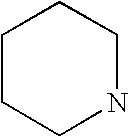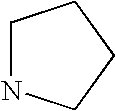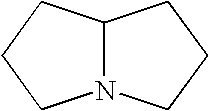Treatment of protein folding disorders
a protein and disorder technology, applied in the field of lysosomal storage, can solve the problems of pathological protein deficiency, accumulation of particular substrates, and entire process, and achieve the effect of enhancing the normal folding of proteins
- Summary
- Abstract
- Description
- Claims
- Application Information
AI Technical Summary
Benefits of technology
Problems solved by technology
Method used
Image
Examples
example 1
Identification of Pharmacoperones for α-Mannosidase
[0173]Fresh solutions had been prepared a day or so earlier of 0.2M Mcllvane buffer at pH 4.5 and 5 mM PNP-α-D-mannopyranoside (Sigma, N2127) in pH 4.5 buffer. Also prepared was a dilution of Jack bean α-D-mannosidase enzyme (Sigma, M7257, 22 Units / mg, 6.2 mg / ml.) at 0.6 Units / ml in pH 4.5 buffer.
[0174]The incubation mixture consisted of 10 μl enzyme solution, 10 μl of 1 mg / ml aqueous inhibitor solution and 50 μl of 5 mM substrate made up in buffer at the optimum pH for the enzyme. The reactions were stopped by addition of 70 μl 0.4M glycine (pH 10.4) during the exponential phase of the reaction, which had been determined at the beginning using uninhibited assays in which water replaced inhibitor. Final absorbances were read at 405 nm using a Versamax microplate reader (Molecular Devices). Assays were carried out in triplicate, and the values given are means of the three replicates per assay. Results were expressed as a percentage o...
example 2
Identification of Pharmacoperones for Beta-Glucocerebrosidase
[0180]I. beta-glucocerebrosidase Activity Assay
[0181]Human Caucasian promyelocytic leukaemia cells (HL60, ECACC No. 98070106) were cultured using a standard sub-culture routine and lysed. The lysates were used as a source for wild type (wt) beta-glucocerebrosidase and used in an assay to determine the enzyme activity and conduct inhibition studies.
i) Cell Lysate Preparation
[0182]HL60 cells were cultured to confluency and washed twice with PBS. Cells were lysed by the addition of lysis buffer (citric phosphate buffer (pH5.2), 0.1% Triton X-100, 0.25% taucholate) at 10×106 cells / ml and incubated at 25° C. for 5 min. Lysates were cleared by centrifugation (400 g, 25° C., 5 min) and protein concentration was determined by using QuantiPro BCA assay kit (Sigma-Aldrich). Lysates were stored in aliquots at −80° C.
ii) beta-glucocerebrosidase Activity Assay
[0183]4-Methlyumbelliferyl β-D-glucopyranoside (4MU-β-D-glc) (Sigma) was used...
example 3
Identification of Pharmacoperones for alpha-galactosidase
I. Alpha-galactosidase Activity Assay
[0188]Human Caucasian promyelocytic leukaemia cells (HL60, ECACC No. 98070106) were cultured using a standard sub-culture routine and lysed. The lysates were used as a source for wild type (wt) alpha-galactosidase and used in an assay to determine the enzyme activity and conduct inhibition studies.
i) Cell Lysate Preparation
[0189]Cell lysates were prepared as described above (Gaucher's I.i)
ii) Alpha-galactosidase Activity Assay
[0190]4-Methlyumbelliferyl alpha-galactopyranoside (4MU-α-D-gal) (Sigma) was used as a substrate to measure alpha-galactosidase activity in HL60 lysate. Enzyme assays were performed in 96-well microtitre plates. Thawed cell lysate and 0.5 mM 4MU-α-D-gal in citric phosphate buffer (pH 4.5) containing 0.1M N-acetylgalactosamine (50 μl final reaction volume) were mixed and incubated at 37° C. The reaction was quenched with 150 μl 0.5M sodium carbonate. The activity was me...
PUM
| Property | Measurement | Unit |
|---|---|---|
| Composition | aaaaa | aaaaa |
Abstract
Description
Claims
Application Information
 Login to View More
Login to View More - R&D
- Intellectual Property
- Life Sciences
- Materials
- Tech Scout
- Unparalleled Data Quality
- Higher Quality Content
- 60% Fewer Hallucinations
Browse by: Latest US Patents, China's latest patents, Technical Efficacy Thesaurus, Application Domain, Technology Topic, Popular Technical Reports.
© 2025 PatSnap. All rights reserved.Legal|Privacy policy|Modern Slavery Act Transparency Statement|Sitemap|About US| Contact US: help@patsnap.com



